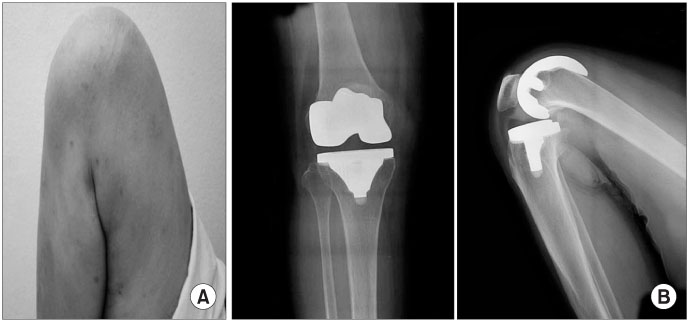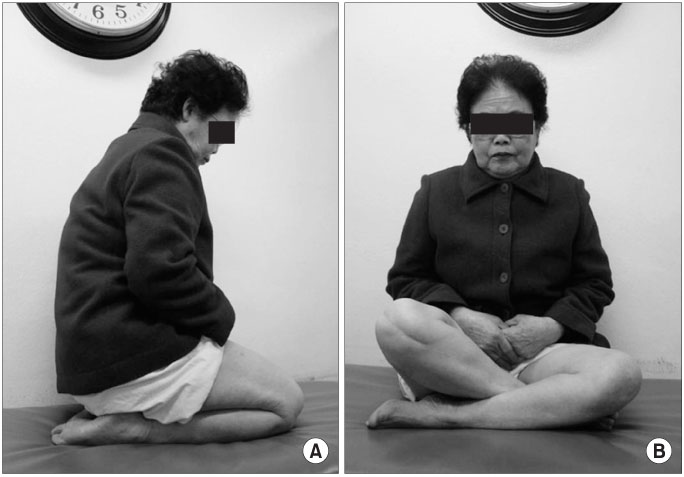J Korean Orthop Assoc.
2007 Feb;42(1):64-70. 10.4055/jkoa.2007.42.1.64.
Range of Motion after High-Flexion Posterior Stabilized Total Knee Arthroplasty: Minimum 3-year Follow Up
- Affiliations
-
- 1Department of Orthopaedic Surgery, Masan Medical Center, Masan, Korea.
- 2College of Medicine, Gyeongsang National University, Jinju, Korea. hychan@gaechuk.gsnu.ac.kr
- 3 Purpose: The purpose of this prospective study was to determine the factors that can be used to predict the postoperative range of motion, and to evaluate the short-term clinical results after total knee arthroplasty (SuperflexTM, Stryker Howmedica Osteo
- KMID: 2106377
- DOI: http://doi.org/10.4055/jkoa.2007.42.1.64
Figure
Cited by 1 articles
-
Influence of Patellar Tilt Angle in Merchant View on Postoperative Range of Motion in Posterior Cruciate Ligament-Substituting Fixed-Bearing Total Knee Arthroplasty
Jegyun Chon, Taehyeon Jeon, Jayeong Yoon, Deukhee Jung, Chung-Han An
Clin Orthop Surg. 2019;11(4):416-421. doi: 10.4055/cios.2019.11.4.416.
Reference
-
1. Anouchi YS, McShane M, Kelly F Jr, Elting J, Stiehl J. Range of motion in total knee replacement. Clin Orthop Relat Res. 1996. 331:87–92.
Article2. Cho SH, Ha YC, Song HR, et al. High Flex knee arthroplasty and range of motion. J Korean Orthop Assoc. 2004. 39:662–667.
Article3. Cho WS, Park JH, Kim JM, Hwang WY, Nam TS. Factors affecting range of motion after total knee arthroplasty. J Korean Orthop Assoc. 2003. 38:683–688.
Article4. Edwards E, Miller J, Chan KH. The effect of postoperative collateral ligament laxity in total knee arthroplasty. Clin Orthop Relat Res. 1988. 236:44–51.
Article5. Fehring TK, Valadie AL. Knee instability after total knee arthropasty. Clin Orthop Relat Res. 1994. 299:157–162.6. Insall JN, Dorr LD, Scott RD, Scott WN. Rationale of the Knee Society clinical rating system. Clin Orthop Relat Res. 1989. 248:13–14.
Article7. Insall JN, Hood RW, Flawn LB, Sullivan DJ. The total condylar knee prosthesis in gonarthrosis. A five to nine-year follow-up of the first one hundred consecutive replacements. J Bone Joint Surg Am. 1983. 65:619–628.
Article8. Kanekasu K, Banks SA, Honjo S, Nakata O, Kato H. Fluoroscopic analysis of knee arthroplasty kinematics during deep flexion kneeling. J Arthroplasty. 2004. 19:998–1003.
Article9. Lizaur A, Marco L, Cebrian R. Preoperative factors influencing the range of movement after total knee arthroplasty for severe osteoarthritis. J Bone Joint Surg Br. 1997. 79:626–629.
Article10. McAuley JP, Harrer MF, Ammeen D, Engh GA. Outcome of knee arthroplasty in patients with poor preoperative range of motion. Clin Orthop Relat Res. 2002. 404:203–207.
Article11. Myles CM, Rowe PJ, Walker CR, Nutton RW. Knee joint functional range of movement prior to and following total knee arthroplasty measured using flexible electrogoniometry. Gait Posture. 2002. 16:46–54.
Article12. Ritter MA, Montgomery TJ, Zhou H, Keating ME, Faris PM, Meding JB. The clinical significance of proximal tibial resection level in total knee arthroplasty. Clin Orthop Relat Res. 1999. 360:174–181.
Article13. Rorabeck CH, Bourne RB, Lewis PL, Nott L. The Miller-Galante knee prosthesis of the treatment of osteoarthritis. A comparison of the results of partial fixation with cement and fixation without any cement. J Bone Joint Surg Am. 1993. 75:402–408.14. Schurman DJ, Parker JN, Ornstein D. Total condylar knee replacement. A study of factors influencing range of motion as late as two years after arthroplasty. J Bone Joint Surg Am. 1985. 67:1006–1014.
Article15. Stern SH, Insall JN. Total knee arthroplasty in obese patients. J Bone Joint Surg Am. 1990. 72:1400–1404.
Article16. Tew M, Forster IW, Wallace WA. Effect of total knee arthrolasty on maximal flexion. Clin Orthop Relat Res. 1989. 247:168–174.17. Warren PJ, Olanlokun TK, Cobb AG, Walker PS, Iverson BF. Laxity and function in knee replacements. A comparative study of three prosthetic designs. Clin Orthop Relat Res. 1994. 305:200–208.
Article18. Yamakado K, Kitaoka K, Yamada H, Hashiba K, Nakamura R, Tomita K. Influence of stability on range of motion after cruciate-retaining TKA. Arch Orthop Trauma Surg. 2003. 123:1–4.
Article19. Yamazaki J, Ishigami S, Nagashima M, Yoshino S. Hy-Flex II total knee system and range of motion. Arch Orthop Trauma Surg. 2002. 122:156–160.
Article
- Full Text Links
- Actions
-
Cited
- CITED
-
- Close
- Share
- Similar articles
-
- Evaluation of Postoperative Range of Motion and Functional Outcomes after Cruciate-Retaining and Posterior-Stabilized High-Flexion Total Knee Arthroplasty
- Outcomes of the Different Types of Total Knee Arthroplasty with the Identical Femoral Geometry
- Two- to Four-Year Follow-up Results of Total Knee Arthroplasty Using a New High-Flexion Prosthesis
- High-Flexion Posterior-Stabilized Total Knee Prosthesis: Is It Worth the Hype?
- Analysis of the Factors that Influence the Range of Motion after Total Knee Arthroplasty





